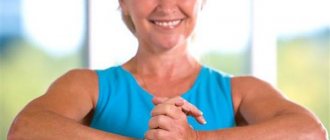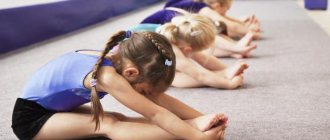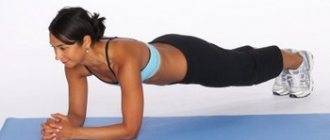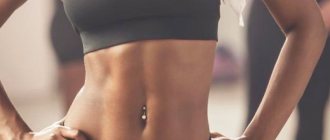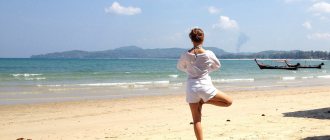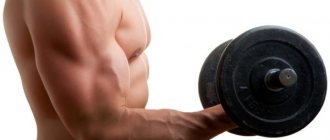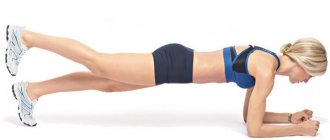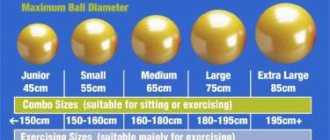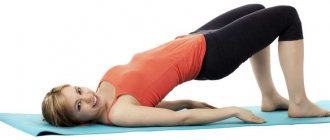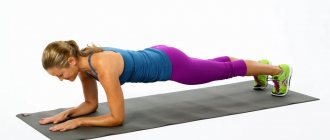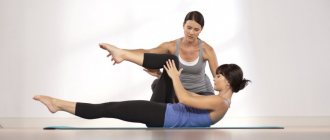Why do you need to do exercises for the spine?
Diseases of the musculoskeletal system are rapidly becoming younger today. “If previously they were diagnosed in elderly and mature people, today every second teenager has deviations in the health of the spine,” comments Olga Zaichenko, personal trainer at World Gym - Krasnodar .
The main reason, experts say, is that most of us spend too much time sitting and don't take care of our posture. “When we come home from work, we spend our free time mostly lying in front of the TV or sitting at a laptop. Children prefer to hang out on social networks or play computer games,” adds Olga.
However, back discomfort is often caused by other factors. “Back pain can have different causes: urolithiasis, cystitis, pyelonephritis, inflammation of the uterine appendages, pathology of the prostate gland, arthrosis, dorsalgia, hypomobility, radiculitis, cervicalgia and much more; a doctor should make an accurate diagnosis,” says Anastasia Dementieva, personal trainer of the “Territory Fitness” club network.
But the most popular diagnosis with which a patient comes to a trainer for a long time remains osteochondrosis. “This is a dystrophic change in the intervertebral disc and the vertebral bodies adjacent to it. There are cervical, thoracic, lumbar and sacral osteochondrosis. The main symptoms indicating its presence are pain, sensory disturbances, muscle atrophy, dysfunction, and dysfunction of internal organs,” adds Anastasia. “Osteochondrosis may be followed by the development of protrusion and hernia.”
The prevention of all these conditions (and sometimes a cure for them) can be properly selected exercises for the spine. “When we move little, the spine stops receiving nutrients and begins to deteriorate. The spinal discs flatten and compress the nerve endings. The passage of nerve impulses to internal organs is disrupted. Moderate activity and special exercises will help avoid all this,” comments Olga Zaichenko.
Length, width and thickness
The parameters of standard rugs are 180 cm in length and 60 cm in width. And yet it is best to select them individually for yourself.
There is a simple rule: ideally, the mat should be 10-15 centimeters longer than your height, so that you can lie down on it completely - also with a small margin. And if the activity involves a lot of movement (for example, lunges), then it is better to find a mat that is even longer in length.
As for the thickness of the mat, the nature of the activity is of decisive importance. If you know that during training you will experience stress on your knees and elbows, then it is better to protect yourself from pain - you don’t need to add unnecessary discomfort to your exercises, because usually the load already creates stress.
- There are thin mats with a width of 1.5 to 3 mm - they are not so practical and, perhaps, allow you to simply not lie on the ground. They are chosen, as a rule, by pro-level yoga fans who, with experience, no longer need comfortable soft surfaces for practice.
- 4 mm is the standard and optimal mat thickness for most people who work out in the gym. Such a rug will provide the necessary comfort: you will not feel the cold from the floor and its unpleasant hardness.
- Rugs with 6-8 mm are suitable for those who are more sensitive and feel more strongly
- Mats with a thickness of 8 mm or more also exist, but difficulties may arise with them during indoor classes: it may not be so easy to maintain balance on such mats. However, this is a practical choice if you plan to exercise outside - outdoor training requires thicker mats.
What exercises for the spine are effective?
Conventionally, they can be divided into several groups:
1) Aimed at working with the joints of the spine . They improve the nutrition of intervertebral discs and the production of synovial fluid. This is important for the prevention of musculoskeletal diseases.
2) Those that strengthen the back and core muscles. The antagonist muscle of the lumbar region is the abs and core in general. By strengthening these muscles, we seem to create additional support for the spine.
3) Relaxes muscles. “The spinal segment includes reflexively tense muscles: intertransverse, rotator cuff, interspinous. And they are almost always severely cramped. Therefore, it is necessary to regularly relax these muscles,” says Anastasia.
Among the exercises for the spine that can be performed at home are the plank, hyperextension, “cat”, lifting the pelvis from a lying position, etc.
However, you should not refuse exercises using strength training machines or functional training equipment. We asked Anastasia Dementieva to put together a set of such exercises and show us.
Treatment of flat feet, consequences and prevention
Various forms of flat feet are diagnosed in 45% of adult patients. They contact orthopedists with complaints of pain while walking, corns on the soles, and rough skin growths. Conservative therapy is effective only at the initial stage of flat feet. In case of severe deformities, patients are advised to undergo surgical intervention - excision of bone sections, plastic surgery of the joint capsule and tendon transplantation.
What is flat feet
Flat feet is a change in the shape of the arch of the foot, in which its shock-absorbing (spring) functions are lost. Due to improper distribution of loads, muscles and ligamentous-tendon apparatus weaken. As a result, the foot becomes painfully flat, “sinks,” and does not soften the shocks that occur while walking. They are transmitted upward to the legs and spine, which causes the development of degenerative pathologies.
Types of disease
There are two arches in the human foot - transverse and longitudinal. They are elastic, but at the same time quite hard, equipped with powerful muscles and ligaments. Thanks to these formations, a person maintains balance while walking, raises and lowers his feet when moving. When the shape of the transverse arch changes, transverse flatfoot is diagnosed. If the structures of the longitudinal arch are deformed, then longitudinal flatfoot is detected. They differ not only in symptoms, but also in the treatment methods used.
Longitudinal
Longitudinal flatfoot accounts for about 25% of cases. Young people aged 16 to 25 are more susceptible to it. Longitudinal flatfoot manifests itself in lengthening of the foot and its flattening. When walking, almost the entire sole rests on the floor surface.
As the pathology progresses, bones and ankle ligament muscles become involved in the degenerative process. The heel bone rotates inward while the forefoot rotates outward. The peroneal tendons become tense and the tibialis anterior tendons relax. Due to the widening of the midfoot and the strong pointing of the toes to the sides, the gait becomes awkward.
Transverse
This is the most common type of flatfoot, diagnosed in 75% of patients. It is found 20 times less often in men than in women. Transverse flatfoot is characterized by a decrease in the length of the foot, a fan-shaped discrepancy of the metatarsus bones, valgus deformity of the big toe (“bunion”), and hammertoes.
The reason for such pronounced changes is the weakening of the muscular-ligamentous apparatus and the plantar aponeurosis - a wide tendon plate formed from dense collagen and elastic fibers. As a result of increased pressure of the heads of the metatarsal bones, the subcutaneous fatty tissue on the sole becomes thinner, and corns form.
Degrees of flat feet
In orthopedics, there are 3 degrees of severity of flat feet. They are interconnected with the severity of signs of bone deformation, determined using radiographic examination. The higher the degree of pathology, the more intense the clinical manifestations.
| Degree of flat feet | Transverse | Longitudinal |
| First | The angle between the first toe and the first metatarsal bone is less than 20 degrees. Flat feet are mild | The height of the arch is less than 35 mm. The severity of the resulting changes is insignificant |
| Second | Angle from 20 to 35 degrees. X-rays reveal moderate deformation of bone structures | The first signs of destructive-degenerative damage to bone structures are revealed. Arch height - 25-17 mm |
| Third | Angle greater than 35 degrees. The foot is flattened, muscles, ligaments, tendons are affected | The height of the arch is less than 17 mm. There is rotation and flattening of the forefoot, deviation of the big toe outward |
Reasons for appearance
Flat feet can be acquired or congenital. The latter is diagnosed very rarely - in approximately 3% of cases after 5-6 years. This late detection of pathology is explained by insufficient development of the foot in childhood. Acquired flat feet can occur in both children and adults. It is classified depending on the factors that provoked it:
- static. Appears due to weakness of bones, muscles, and ankles. Foot deformity can be caused by hypermobility of the joints, a hereditary predisposition to the development of flat feet, and excess body weight. It is predisposed to low physical activity, wearing uncomfortable shoes, including high heels;
- traumatic. Becomes a consequence of fractures of the bones of the ankle, foot, heel;
- rachitic. Occurs after suffering from rickets - a disease of children with a disorder of bone formation and insufficient bone mineralization.
Less commonly diagnosed is paralytic flatfoot, which develops after polio. The reason for the change in the shape of the arch of the foot is paralysis (complete absence of voluntary movements) of the tibial and plantar muscles.
Symptoms of the disease
The severity of symptoms varies somewhat with transverse and longitudinal flatfoot. The latter at the initial stage is manifested by rapid fatigue when moving, pain in the lower leg and upper part of the arch. The discomfort increases significantly after standing for a long time. And with transverse flatfoot, pain occurs even after a slight static load. It is characterized by a clearly visible decrease in the arch, provoking a change in gait.
In adults
Doctors note that patients come mainly with complaints of coarsening of the skin of the sole and the formation of corns. And only during the survey it turns out that they are bothered by pain when walking and standing on their feet for a long time. Patients do not connect these symptoms with each other, considering them signs of different diseases. During the examination, the development of temporary contractures is also revealed - conditions in which the foot cannot fully flex and extend. At the stage of moderate deformation, pain can be burning, piercing, and radiating to neighboring areas of the body.
In children
The main clinical manifestations are increased fatigue when walking and standing, rapid wear of shoes along the inner edge of the sole and heel. The child complains of aching pain in the foot, which intensifies with prolonged standing. He gets tired quickly even after walking short distances. Pathology is also indicated by swelling in the ankle area in the evening. If the deformity is severe, the child cannot walk in ordinary shoes and experiences lumbar pain and headaches.
Determining flat feet at home
Home diagnostics for flat feet are quite superficial. With its help, it will not be possible to detect the disease at the initial stage of development, to establish its type and severity. However, if a pathological change in the shape of the vault is suspected, it makes sense to do some testing. What indicates flat feet:
- gradual or sudden appearance of a feeling of fatigue when walking for a long time. Soreness and heaviness in the leg muscles can occur both during a walk and in the evening. Foot baths or local application of ointments and gels with an analgesic effect can help get rid of it;
- inability to stand for long periods of time. After a short time, discomfort arises, which can be eliminated by moving from foot to foot;
- when bending or straightening the fingers strongly, some restriction is felt. Often, in the area of greatest stiffness, you can feel a flat and hard connective tissue cord.
An attentive person may notice that his prints on wet sand or soil have changed. With flat feet, it becomes much wider. Not only the outer part, but also the inner part of the sole is imprinted.
Diagnostics
The primary diagnosis is made on the basis of an external examination - changes in the length, width and range of motion of the foot. Confirmation is provided by medical history and patient complaints, including those about quickly wearing out shoes. Instrumental diagnostics are carried out to establish the severity of the pathology and exclude diseases with similar symptoms, for example, osteoarthritis of the ankle joint. The most informative studies are:
- radiography in frontal and lateral projections;
- podometry - measurement of the time characteristics of a step when walking;
- plantography is a method of obtaining foot prints (footprints), allowing one to judge its spring function.
Patients are also given clinical blood and urine tests to assess their overall health. According to indications, biochemical studies are carried out to exclude rheumatic pathologies.
Treatment of flat feet
An integrated approach to the conservative treatment of longitudinal and transverse flatfoot of 1st degree of severity is practiced. Patients are advised to reduce the load on the injured foot and, if necessary, lose weight. It is necessary to develop the correct motor stereotypes and correct the position of the legs while walking.
Orthopedic shoes
Orthopedic correction is the main part of the treatment of flat feet in children. In adults, it is effective for mild deformation of bone structures. Boots, shoes, sandals, and slippers can be purchased at orthopedic stores. It is equipped with a small heel, a comfortable instep support, and a shock-absorbing sole.
For severe foot deformities in children, doctors recommend wearing shoes made to order according to the measurements taken. It is significantly more expensive, but the therapeutic effect of its use is much higher.
Mat for foot treatment
Walking barefoot on sand, grass, small and large pebbles is very useful for any type of flat feet. It stimulates improved blood circulation in the legs and strengthens the muscular-ligamentous apparatus. At home, walking on an orthopedic mat will help you achieve this result. It consists of several interchangeable compartments, the surface of which imitates pebbles and sand. Orthopedists recommend walking on such a mat for 15 minutes up to 3 times a day.
Exercises
Physical therapy is the most effective way to stop further deformation by strengthening the ankle muscles. But only daily exercise will ensure maximum therapeutic effect. The first classes are conducted under the guidance of a physical therapy doctor. He shows how to perform exercises correctly so that, while strengthening the muscle corset, the deformation of cartilage and bones does not accelerate. The most effective for flat feet are circular rotations of the foot, grasping small objects with the fingers, and rolling a bottle filled with water with the sole on the floor.
Massage for flat feet
Patients are prescribed up to 20 professional massage sessions. At the initial stage of the procedures, stroking and rubbing are performed. After accelerating local blood flow, the massage therapist begins more energetic movements - kneading, vibrations. The main goals of massage are to increase range of motion in the feet by removing muscle blocks and eliminating pain.
Therapeutic baths
Therapeutic baths help get rid of the feeling of heaviness in the legs and stiffness of movement. One basin is filled with cool water (18-20°), the other with warm water (25-30°). Place your feet for 3 minutes, first in one, then in the second container 5-7 times. At the end of the procedure, vigorously rub your feet with a hard towel. The following baths are also useful:
- saline. 5 tablespoons of sea salt are diluted in 2 liters of hot water. Filter, cool to a comfortable temperature, immerse the feet in water for 20 minutes;
- herbal. Pour 2 liters of boiling water over 50 g of dry medicinal plants. After an hour, filter, cool slightly, and take a bath for 30 minutes.
For flat feet, pine needles, birch buds, eucalyptus leaves, and marigold flowers are especially useful. You can add a couple of drops of essential oils of thuja, cypress, spruce, and thyme to the bath water.
Surgical intervention
Longitudinal flatfoot is eliminated by performing various plastic surgeries: resection of bone sections, tendon transplantation, plastic surgery of joint capsules. In the transverse form of the pathology, an isolated intervention is possible, for example, surgical correction of the thumb with excision of overgrown bone tissue.
Doctors warn that if the shape of the arch has changed due to weakness of the ligaments and tendons, then there is a high probability of relapse. Patients are advised to constantly wear orthopedic insoles with built-in arch supports.
Pull-ups with TRX loops
Attach the TRX loops to the support so that the handles reach chest level. Stand facing them, grab the handles with both hands. Lean your body back slightly so that your body from your toes to the top of your head is in one line and your arms are extended. Work your abdominal, back and arm muscles. Gently and slowly bend your elbows, pull your body forward, then return to the starting position. This will amount to one repetition. Perform 3 sets of exercises of 10 repetitions each.
Rules of care
In order for the rug to last as long as possible, it needs to be properly cared for. A few general recommendations will allow you to enjoy it for more than one year:
- Carefully study the manufacturer's recommendations.
- You can only exercise in socks or barefoot.
- Fold it only if there are segments, otherwise roll it up.
- The roll should not be too dense; roll it from a different side each time.
- Synthetic materials are rinsed by hand once every 1-2 months (depending on the intensity of exercise) in a warm soapy solution and dried in a vertical position.
- Natural products are wiped with a damp cloth.
- To avoid odor, after each workout the mat should be hung out in the fresh air for a couple of hours.
- As soon as peeling and creases appear, purchase a new one.
- This is the same personal hygiene item as a towel or comb, so do not let other people use it.
The service life is 50% dependent on proper care. The remaining 50% depends on the intensity of training and the quality of the product.
Gluteal Bridge
Lie on your back, bend your knees, extend your arms along your body. Don't wring your neck. Slowly lift your pelvis and spine off the floor, lifting one vertebra at a time from the mat. At the top point, fixate yourself on the back of your head, arms, shoulder blades and feet. Also smoothly return to the starting position. This will amount to one repetition. Perform 3 sets of exercises of 10 repetitions each.
Yoga mats: why are they needed?
Gymnastics mats are essential for a variety of workouts, but especially for fitness classes, Pilates and yoga. Their use allows:
- when performing static exercises, avoid sliding on the mat;
- reduce pain on the elbows and knees when placing emphasis on them;
- reduce spinal tension during exercise;
- soften the foot during the jump when hitting the surface;
- keep your feet warm without allowing the feeling of a cold floor;
- increase the comfort of exercise throughout the workout.
As you can see, a mat is not just a fad or a fashion brand, it is an important workout attribute that can reduce pressure on your joints and increase the effectiveness of your workout. In addition, the sweat released during exercise will be absorbed by the mat (except for those made on the basis of thermoplastic elastomer), which is already hygienic and prevents the spread of bacteria.
In order for the quality of the purchased product to be of a high level, it is necessary to take into account the following requirements when choosing:
- two surfaces must be made of non-slip material;
- the elasticity of the material should not be stretchable under the influence of the exercises performed;
- during training, the mat should tear or crumble;
- The material has a soft feel to the touch;
- the manufacturing material is hard enough so that when lying on your back you don’t feel the floor surface;
- absence of pungent odors and release of various toxic compounds.
"Cat"
Get down on all fours, place your palms under your shoulders, knees under your pelvis. Do not increase the arch in your lower back, try to maintain a natural line. As you exhale, stretch your shoulder blades up and lower your head down. Feel the stretch in your back muscles. As you inhale, lower your chest down and pull your chin forward and up. This will amount to one repetition. Perform 3 sets of exercises of 10 repetitions each.
Arm and leg raise
Get down on all fours, place your palms under your shoulders, knees under your pelvis. Activate your abdominal and back muscles. Maintaining a natural arch in your lower back, extend your right arm (forward) and left leg (backward) over the mat. Try to keep your body motionless and parallel to the floor. Then smoothly return to the starting position and do the same in the other direction. This will amount to one repetition. Perform 3 sets of exercises of 10 repetitions each.
How to choose a gymnastic mat for fitness?
For home use, we can recommend several mats that are suitable for training on different parts of the body, using dumbbells and weights. They should not slip, they should be easy to clean, and you should also pay attention to whether the rugs are prone to collecting harmful microorganisms (this can happen more often with rugs made from natural materials).
Which rug should I buy?
There are many offers on the market, some of them can be cited.
- Gymnastic mat Bradex (price is approximately 850-900 rubles). Non-slip mat 0.3-0.5 cm thick with rounded edges. Due to its thickness, it is suitable for abdominal exercises and does not slip.
- Mat from Verdani model “Sport” (combines good quality at a reasonable price of 300 rubles). The corrugated rug is made of polyethylene foam and has a short length of up to 180 cm. It is well suited for the home, as it does not allow heat or cold, as well as moisture, to pass through. You can do any muscle development exercises.
- Spokey rug (price around 1000 rubles). Very durable, does not slip at all. It folds easily, has handles for carrying, and lasts a long time. Easy to store as it has straps for folding.
- Feco rug . A thin mat costs up to 800 rubles and has a storage case. Designed for abdominal exercises and leg swings.
- Alonsa products have a price range from 200 to 600 rubles. The shape allows you to perform exercises while lying down and is not prone to slipping. Has handles for carrying.
Press crunch
Lie on your back, press your lower back to the floor. Bend your legs at the knees and lift them above the floor, placing your shins parallel to it. Place your palms behind your head, bend your elbows. Exhale, lift your shoulders, shoulder blades and head above the floor, twist your upper body to the left. Direct your right elbow towards your left knee, extend your right leg parallel to the floor. This will amount to one repetition. Perform 3 sets of the exercise , 10 repetitions in each direction.
Plank
Take a lying position, leaning on straight arms and toes. Place your palms clearly under your shoulders. Activate the muscles of your abs, legs, back and arms. Don't arch at the waist. Stretch your heels back and the top of your head forward. Don't wring your neck. Lock in this position for 1 minute . Then lower your knees to the floor, rest for 30 seconds, and then repeat the exercise.
Exercise therapy for scoliosis: how to perform therapeutic exercises
Have you been trying to heal your JOINTS for many years?
Head of the Institute for Joint Treatment: “You will be amazed at how easy it is to heal your joints by taking every day...
Read more "
It is possible to cure acquired curvature of the spine if the disease is not advanced. Exercise therapy for scoliosis is considered one of the effective methods.
With the help of the correct implementation of a set of exercises and clear monitoring of the patient’s condition, it is possible to bring the curvature of the spine back to normal.
If scoliosis is a congenital anomaly, physical therapy is not prescribed by the doctor - some physical exercises can harm the patient.
The effectiveness of exercise therapy for scoliosis
Doctors do not undertake to make predictions about how effective scoliosis treatment will be. Healing depends on many factors: the type of changes in the vertebra, its shape, the degree of the disease. The treatment is long-term. For children 10-15 years of age, gymnastics for scoliosis at home will help completely correct the curvature, because the skeleton is still growing and the body is developing. Scoliosis of 1-2 degrees can also be corrected.
Doctors, when recommending a set of exercises for scoliosis, emphasize that it is necessary to undergo additional therapeutic measures in parallel.
Patients are prescribed massages, physiotherapy, and wearing a therapeutic corset, which corrects many orthopedic abnormalities.
Why is exercise therapy recommended for scoliosis?
Most patients do not understand how physical therapy can affect scoliosis and speed up recovery. In fact, regularly performing spinal stretching exercises increases the possibility of complete healing. Doctors note several main positive aspects of this treatment:
- the muscles and ligaments of a patient with scoliosis are imbalanced, and exercise therapy can eliminate this imbalance;
- exercises to straighten the spine for scoliosis relieve the load on the spinal column and strengthen its muscle tissue;
- posture is corrected, shoulders gradually become in the correct position;
- Exercise therapy has a healing effect on the body.
Bubnovsky offers an effective treatment method and exercises for scoliosis.
The doctor confidently notes that recovery depends on the patient’s assertiveness, but emphasizes that one should be careful when performing exercises for left-sided scoliosis.
What exercises are recommended by Dr. Bubnovsky’s center, watch in the video:
Basic rules of exercise therapy
In the treatment of any ailment there are clearly defined rules that must be followed with full responsibility. Correcting scoliosis with physical exercise is no exception. The patient, following all the recommendations, will not harm himself, and will also quickly approach the moment of full recovery.
There are not many rules, it’s worth memorizing them:
- Classes always begin with a warm-up.
Moreover, the first exercises for the back with scoliosis should be easy and simple.
It is important to prepare the body by warming up the muscle tissue and stretching the ligaments;
- When the body is warmed up, proceed to performing basic gymnastics, each exercise should be repeated 5-10 times, gradually increasing the load;
- The final part of physical education cannot be neglected;
- It is important to do everything smoothly and slowly, no sudden lunges or acrobatic tricks;
- When performing physical exercises with scoliosis, you should not use dumbbells;
- All exercises must be selected by a qualified physician after a thorough examination of the diagnosis.
Exercise to correct posture and correct breathing
A patient with scoliosis must learn to stand and walk correctly. To do this, you need to fix the body in a straight position, leaning against the wall. Then move away from the support, trying not to change the accepted position of your back.
This exercise should be done many times during the day until you develop the habit of keeping your back straight.
Another important recommendation: the patient needs to learn to breathe correctly, and not only during training. According to the famous German doctor Katharina Schroth, gymnastics for scoliosis will not be effective without proper breathing. She recommends learning to inhale more air into the sides of the lungs where the curvature is detected.
The same banned issue for which Ernst fired Malakhov!
Joints and cartilage will be cured in 14 days with the help of ordinary...
Warm-up part of the workout
Before moving on to warm-up exercises, patients are advised to relax their back. To do this, the patient needs to stand on all fours and slowly move around a small area for 10-15 minutes. Now that your back is prepared, you should start warming up and doing exercises for spinal scoliosis at home. You will need to repeat only seven exercises, it is important to do them slowly:
- Inhaling air, raise your hands as if trying to reach the sky, hold, and slowly lower as you exhale.
- Next, the shoulders are warmed up. It is necessary to make several circular movements with them in different directions.
- Raise your palms up and stretch the muscles, pausing briefly while raising your arms.
- Close your hands and take them as far back as possible, feel the stretching of the spine and muscle tissue.
- Perform bending movements, stretching your arms forward.
- While stretching your legs, you need to pull your knees towards your stomach, and then take the starting position.
- Do a few slow squats.
Basic exercises for scoliosis
Immediately after warming up, you should begin basic exercises to correct scoliosis, which will help strengthen the spinal column and relax muscle tissue. First, perform the following exercises while standing:
- press your hands to your shoulders and rotate your elbows in different directions;
- First move the shoulder deformed by scoliosis back, then slowly return it;
- Raise the shoulder opposite to the deformed side and turn it forward so that tension is felt in the area of the shoulder blade;
- inhale the air and, stretching upward, hold your breath, and then exhale, gradually relaxing - breathing exercises for scoliosis are very important.
After performing the exercises while standing, you should spread a gymnastic mat on the floor, lie down and continue physical therapy.
In this position, you need to do the following exercises:
- make movements with your feet that resemble the action of scissors or a bicycle;
- raise your legs, spread them apart and connect them, then lower them to the floor;
- perform a body stretch by stretching your whole body;
- lying on your back, bend one leg at the knee, move it forward, and move your body in the opposite direction - such twists are very effective in treating scoliosis of the 1st degree;
- turning over on your stomach, press your body tightly to the floor, bend your arms and try several times to lift your head and shoulders from the surface;
- perform movements as if you were swimming breaststroke;
- lie on your side, place a cushion under your ankles, raise your legs and fix them, hold for a few seconds, and then slowly lower them.
The final part of physical education
After completing all the main exercises of the treatment course, be sure to move on to the final part.
It is necessary to restore breathing and help the body switch to a calm mode after training.
During the entire confinement, you must walk in place. At the same time, perform the following exercises for curvature of the spine:
- walk on your toes (at least 30 seconds) with your arms raised up;
- clasp your hands behind you and walk on your heels for half a minute;
- stretch your arms forward and perform 5-10 hip raises;
- stand with your back to the wall and, inhaling, raise your arms, and, exhaling, lower them.
It should be remembered that exercise therapy is prescribed by a doctor individually. Making your own decision to perform certain exercises when treating scoliosis is unwise.
The disease at its initial stage can be easily corrected with the help of physical education and comprehensive treatment. If it has moved to the third degree, then the exercises are performed with caution and only while lying on the floor.
Training for beginners with Anna Kurkurina
The famous trainer Anna Kurkurina responsibly states that by training regularly, you can completely cure curvatures in school-age children.
For beginners, it is better to perform exercises in the gym for scoliosis under the close attention of a trainer who will teach you how to do everything correctly and provide protection.
You need to exercise every day. At first it will be difficult, especially if the person is not athletic, but you can’t stop and feel sorry for yourself. For beginners, she advises doing the following exercises to strengthen the back muscles with scoliosis:
- push-ups from the floor with emphasis on the knees;
- arch your back, resting your hands on the floor, and roll your body, bending down and pushing your chest forward;
- hang on the horizontal bar and, trying not to bend your elbows, perform several minor lifts of the body;
- take a prone position, rise and jump up, trying to make the jump as high as possible.
You will find more exercises for scoliosis from Anna Kurkurina in the video:
When performing Anna Kurkurina’s exercises for right-sided scoliosis, it is important to rest after each approach, stretching and clasping your hands behind your back.
Advice from orthopedists for patients with scoliosis
Scoliosis is insidious.
It is enough not to notice its onset or not to take any action for treatment, and it will be impossible to return the spinal column to its normal position.
Orthopedists, when consulting their patients, warn about what exercises should not be done with scoliosis and what anyone with a curvature should pay attention to:
- It is unacceptable to stay in one position for a long time. Every 15-20 minutes you need to change your body position;
- No carrying bags, suitcases or packages in one hand. It is better to purchase a backpack with an orthopedic back or distribute the same weight of the load on both hands;
- Sports activities involving weight lifting, acrobatics, running and jumping are cancelled. If you have scoliosis, it is recommended to swim more often. Carefully perform daily exercises for kyphosis of the thoracic spine. A specialist will select and advise a complex of physical therapy;
- The place to sleep must be equipped with an orthopedic mattress and pillow. Soft surfaces are contraindicated.
Scoliosis most often affects school-age children.
Adults, at the slightest suspicion of spinal curvature, should take the child to the hospital and undergo examination by an orthopedist.
Scoliosis can be treated, but provided that treatment was prescribed on time and the patient strictly followed all the doctor’s recommendations.
Side plank
Lie on your left side. Stretch your legs, rest on the sides of your feet, placing them on the floor one after another. Bend your left elbow and rest on your forearm. Place your right hand on your thigh. Activate your abs, legs and back muscles. Do not bend at the waist, do not twist your neck. As you exhale, lift your pelvis off the floor, and as you inhale, lower it back to the floor. This will amount to one repetition. Perform 3 sets of the exercise , 10 repetitions in each direction.
Functionality
The fitness mat ensures the safety and comfort of training by performing the following functions:
- absorbs sweat;
- provides comfort for classes (the floor is hard and uncomfortable);
- protects the spine, knees, palms, feet, head from injuries and pain;
- prevents colds during the cold season due to drafts moving across the floor;
- lifts the mood;
- an expensive and stylish thing can serve as a good motivation for regular exercise.
In the halls you may be offered mats for common use so that you do not have to bring your own from home each time. But think about the fact that they are rarely washed (if washed at all) and how many bacteria from other people’s bodies accumulate there. In addition, when performing exercises from a lying position, there is always a risk of ending up with your head where someone’s legs were recently. There is only one way to get around these unpleasant moments - buy your own rug.
Reduction of the shoulder blades
Lie on your back, bend your knees, place your feet on the floor. Press your lower back, back of your head, and spine into the mat. Reach back with the top of your head. Stretch your arms up. In this position, squeeze your shoulder blades together and stretch your chest up. Hold for 1-2 seconds
in this position.
Smoothly return to the starting position - spread your shoulder blades. This will amount to one repetition. Perform 20 such repetitions .
What are rugs made of?
The cost and useful characteristics of the rugs depend on the material used. The most inexpensive ones are made from synthetics. This is a good option for beginners and fans of a healthy lifestyle who do not plan to engage in fitness on a regular basis. Polyvinyl chloride (PVC) rugs are resilient and durable, but often have an unpleasant odor. Their service life is shorter than that of products made from other materials (2 years). To practice yoga, you need to take a mat made of dense PVC - it is less slippery.
Thermoplastic elastomer (TPE) is also synthetic. But TPE mats are lighter, softer and very pleasant to the touch. They do not slip, are resistant to heat and cold, do not fade and last twice as long as PVC mats. True, they cost more.
Mats made from natural materials are chosen by teachers and fitness fans who cannot imagine themselves without training. Natural rubber does not slip, does not electrify and does not have an unpleasant odor. To increase strength and elasticity, it is reinforced with cotton and jute threads. Mats made of natural rubber are dense and comfortable, but quite heavy. Beginners can opt for a cheaper option. Products made from high-quality synthetics are not much worse in their characteristics than rubber mats.
Sitting traction
Sit on the bench of the lat pulldown machine. Set the minimum weight. Place your feet flat and grab the handles with your palms. Bring your shoulder blades together, bend your elbows and pull the handles of the lower block towards you. Then smoothly pull your shoulder blades back, round your back, and stretch your arms forward. Don't wring your neck. This will amount to one repetition. Perform 3 sets of exercises of 10 repetitions.
Upper block pull
Sit on the seat of a lat pulldown machine. Set the minimum weight. Bend your knees slightly and place your thighs parallel to the floor. Stretch your crown upward, keeping your back straight. Grab the handle with both hands, palms slightly wider than shoulder-width apart. Bend your elbows and gently squeeze your shoulder blades together. Then return to the starting position with your arms straight. This will amount to one repetition. Perform 3 sets of exercises of 10 repetitions.
